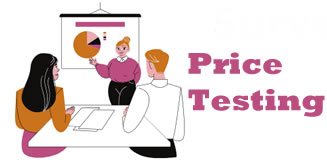Competitor Price tracking methods include customer surveys, competitive pricing analysis, conjoint analysis, price tracking sensitivity analysis, price testing, focus groups, historical sales data analysis, and the use of price optimization software. These methods collectively enable businesses to make informed, strategic pricing decisions to enhance profitability and customer satisfaction.
Competitor Price Tracking methods are techniques and approaches used by businesses to gather data and insights related to pricing decisions. Pricing research methods are essential for businesses for several reasons like pricing strategy development, data-driven decision-making, having a competitive analysis, having customer understanding, price optimization, and of course, adaptation to e-commerce.
Table Of Contents For Competitor Price Tracking Methods
Price Tracking Strategy Development
Competitor Price tracking is a critical element of a business’s overall strategy, and pricing research methods help businesses develop effective pricing strategies. Pricing research methods enable businesses to gather data and insights about customer preferences, market dynamics, and competitor pricing practices, which can inform the development of a pricing strategy that aligns with business objectives and market conditions.
Data-Driven Decision Making
Price trackingresearch methods provide businesses with data and insights that can inform their pricing decisions. By using pricing research methods, businesses can gather quantitative and qualitative data that helps them make informed decisions about pricing levels, pricing models, pricing tactics, and pricing optimization. Data-driven decision-making can result in more effective pricing decisions that are based on evidence rather than guesswork, leading to improved profitability and competitiveness.
Competitive Analysis
Price tracking research methods allow businesses to understand their competitors’ pricing strategies and practices. Businesses can analyze competitors’ pricing levels, promotions, discounts, and other pricing-related activities to gain insights into how they position their products or services in the market and how their prices compare to competitors. This information can help businesses develop competitive pricing strategies that consider market dynamics and competitor pricing actions.
Customer Understanding
Price tracking research methods help businesses understand their customers’ preferences, perceptions, and behaviors related to pricing. By conducting surveys, focus groups, conjoint analysis, and other pricing research methods, businesses can gather insights into customers’ willingness to pay, price sensitivity, and decision-making processes related to pricing. This understanding of customer behavior can help businesses set prices that are attractive to customers while maximizing profitability.
Price Tracking Optimization
Price tracking research methods, such as price testing and price optimization software, enable businesses to optimize their pricing for maximum profitability. By conducting experiments, analyzing historical sales data, and using advanced analytics and machine learning algorithms, businesses can identify pricing opportunities, simulate pricing scenarios, and optimize prices to achieve pricing objectives, such as maximizing revenue, profit margin, or market share.
Adaptation to Market Changes

Markets are dynamic and Price tracking research methods help businesses adapt to changing market conditions. Pricing research methods enable businesses to monitor market trends, customer preferences, and competitive pricing practices, and make adjustments to their pricing strategies accordingly. This helps businesses stay competitive in the market and respond to changing customer demands and competitive pressures.
In summary, Price Monitoring methods are crucial for businesses as they provide data and insights that inform pricing decisions, help develop effective pricing strategies, optimize pricing for maximum profitability, understand customer behavior, and adapt to changing market conditions. By leveraging pricing research methods, businesses can make informed and data-driven pricing decisions that can lead to improved profitability, competitiveness, and customer satisfaction.
Common Pricing Research Methods

Customer Surveys
Conducting surveys among your target customers to gather information about their preferences, perceptions, and willingness to pay for your product or service. Surveys can be conducted online, through email, or in person, and can help you understand how customers perceive the value of your product or service and what they are willing to pay.
Competitive Pricing Analysis: Analyzing the pricing strategies and practices of your competitors to gain insights into their pricing decisions. This can involve monitoring and analyzing competitors’ prices, promotions, discounts, and other pricing-related activities to understand how they position their products or services in the market and how your prices compare to theirs.
Conjoint Analysis
A statistical technique used to understand customers’ preferences and trade-offs among different product or service attributes and their associated prices. Conjoint analysis helps businesses understand the relative importance of different attributes and their impact on customers’ purchase decisions and price sensitivity.
Price Tracking Sensitivity Analysis
Conducting experiments or surveys to measure customers’ price sensitivity and elasticity of demand. This involves varying prices and measuring the corresponding changes in demand to understand how customers react to price changes and how sensitive they are to different price points.
Price Testing

Conducting controlled experiments or tests to evaluate the impact of different pricing strategies or tactics on customer behavior and business outcomes. This can involve testing different price levels, pricing models, or pricing tactics in a controlled environment to understand their impact on sales, profitability, and customer behavior.
Focus Groups: Conducting qualitative research with a small group of customers to gather insights about their perceptions, preferences, and decision-making processes related to pricing. Focus groups can provide in-depth qualitative insights that can help businesses understand customers’ emotions, motivations, and behaviors related to pricing.
Historical Sales Data Analysis
Analyzing historical sales data, including transaction data, pricing data, and other relevant data, to identify pricing patterns, trends, and correlations. This can help businesses identify pricing opportunities, evaluate the effectiveness of past pricing decisions, and make data-driven pricing decisions for the future.
Price Tracking Software
Using specialized pricing optimization software or tools like PriceRest may leverage data and algorithms to analyze pricing data, customer data, and market data to provide recommendations on optimal pricing strategies. PriceRest use advanced technology for its user to gather updated data to optimize prices for maximum profitability.
Having a detailed pricing research method and utilize a price intelligence tool like PriceRest definitely helps the business owners to create maximum profit in a heavily saturated market. Join PrPriceRest cerest today to see the difference.

Do you want to be a successful player in e-commerce?
- You must keep a close monitoring on what your competitors are doing
- Know the product’s pricing points.
- Use Price Monitoring Tools
- Use Dynamic Pricing Strategies
- Automatically Update Your Products According To Your Competitors.
Join PriceRest for better dynamic pricing strategies for your short- and long-term sales processes.
To have a better understanding of e-commerce for success, join today!
And see What PriceRest can do for you.
Request a personalized demo of PriceRest
We look forward to showing you how our platform allows you to optimize the pricing, execution, and measurement initiatives that matter most to your brand and products.
It is Free!
What can I expect?
- A brief conversation to assess what PriceRest can do to help your pricing strategy
- Live product demo with insight into how to get the most benefit from PriceRest
- Discuss your prices KPIs to determine the best path forward for your business
- No commitment required



